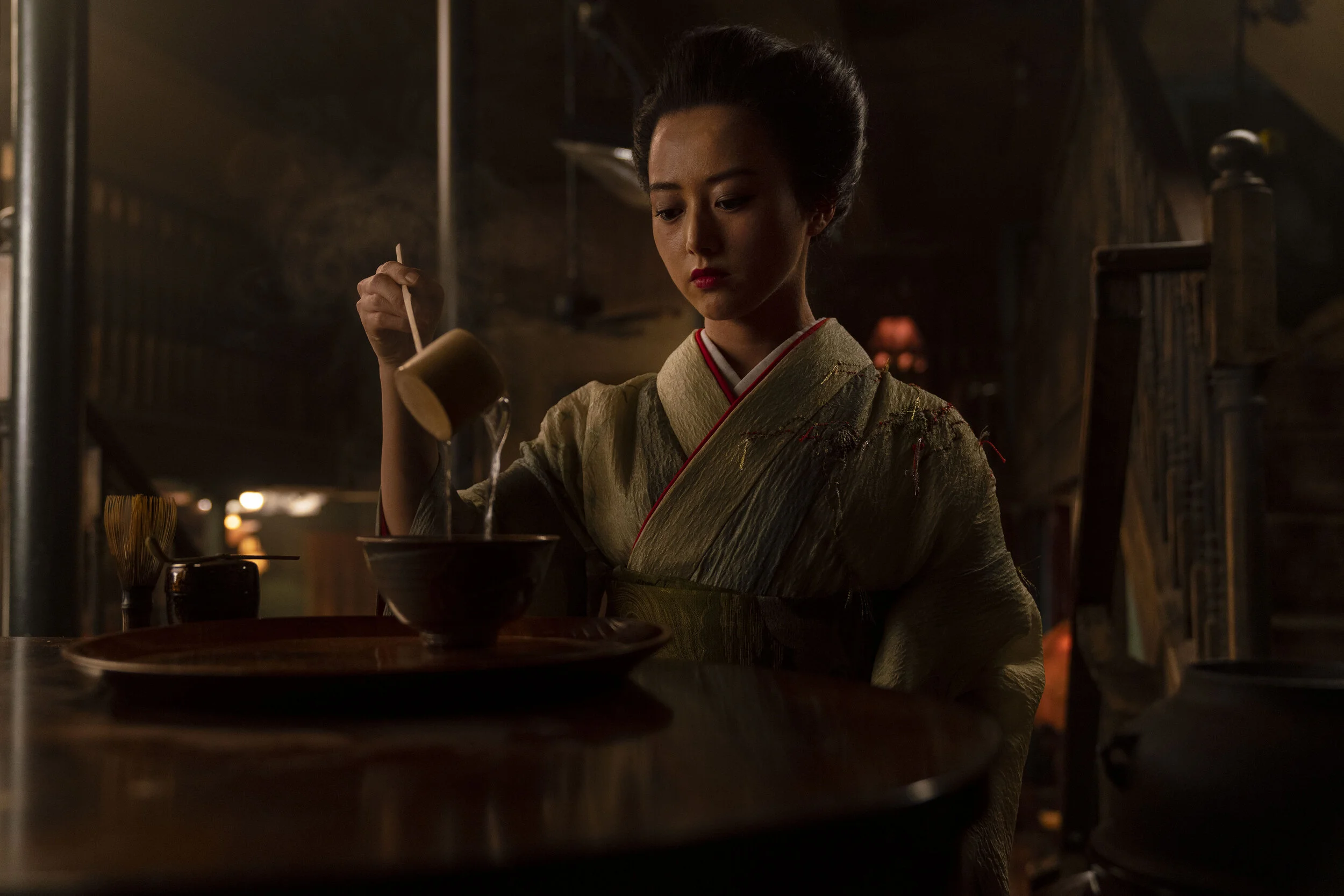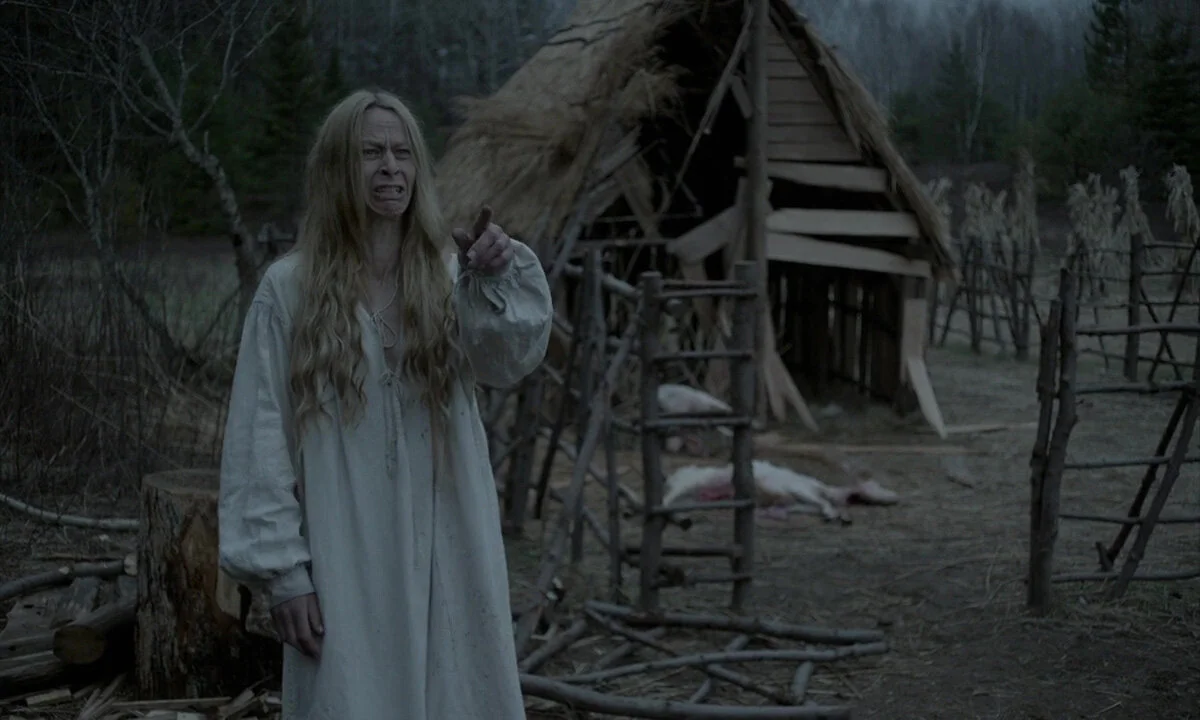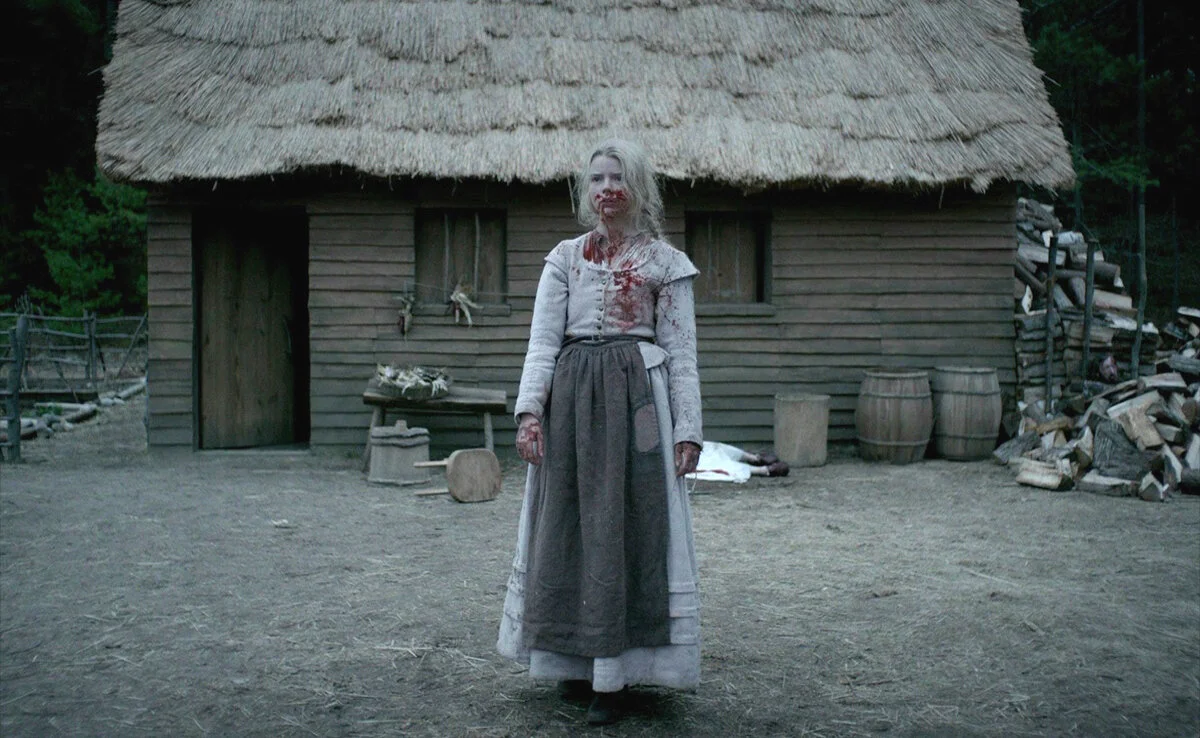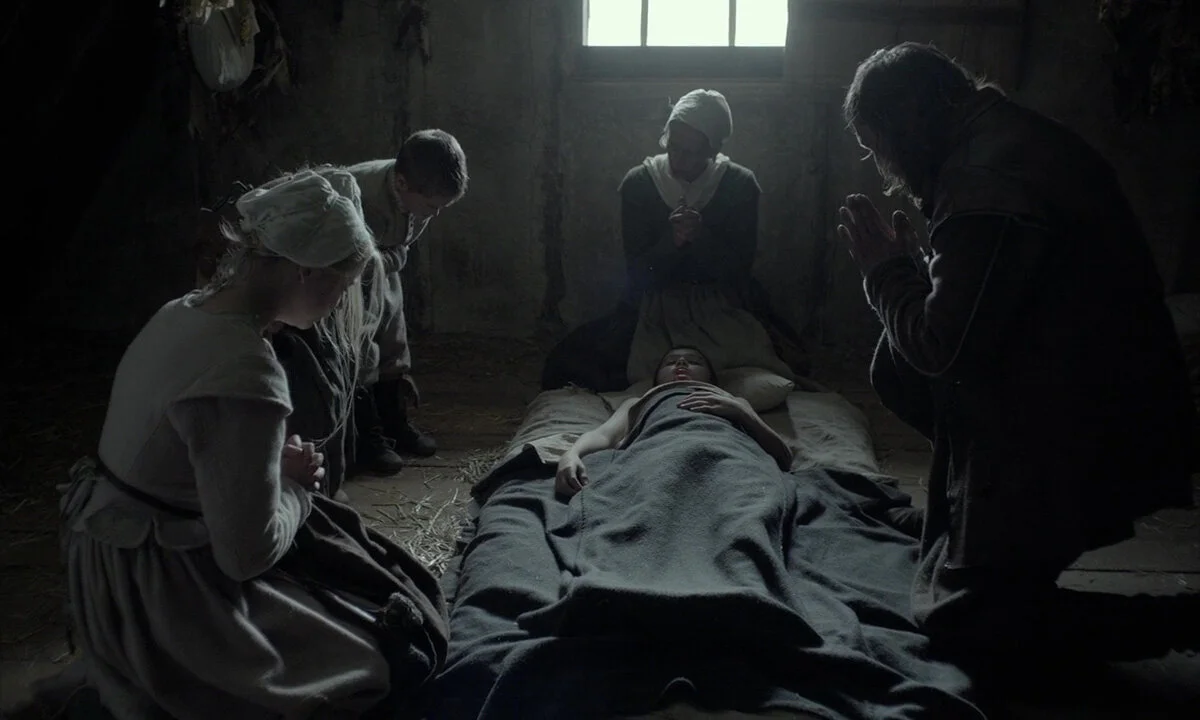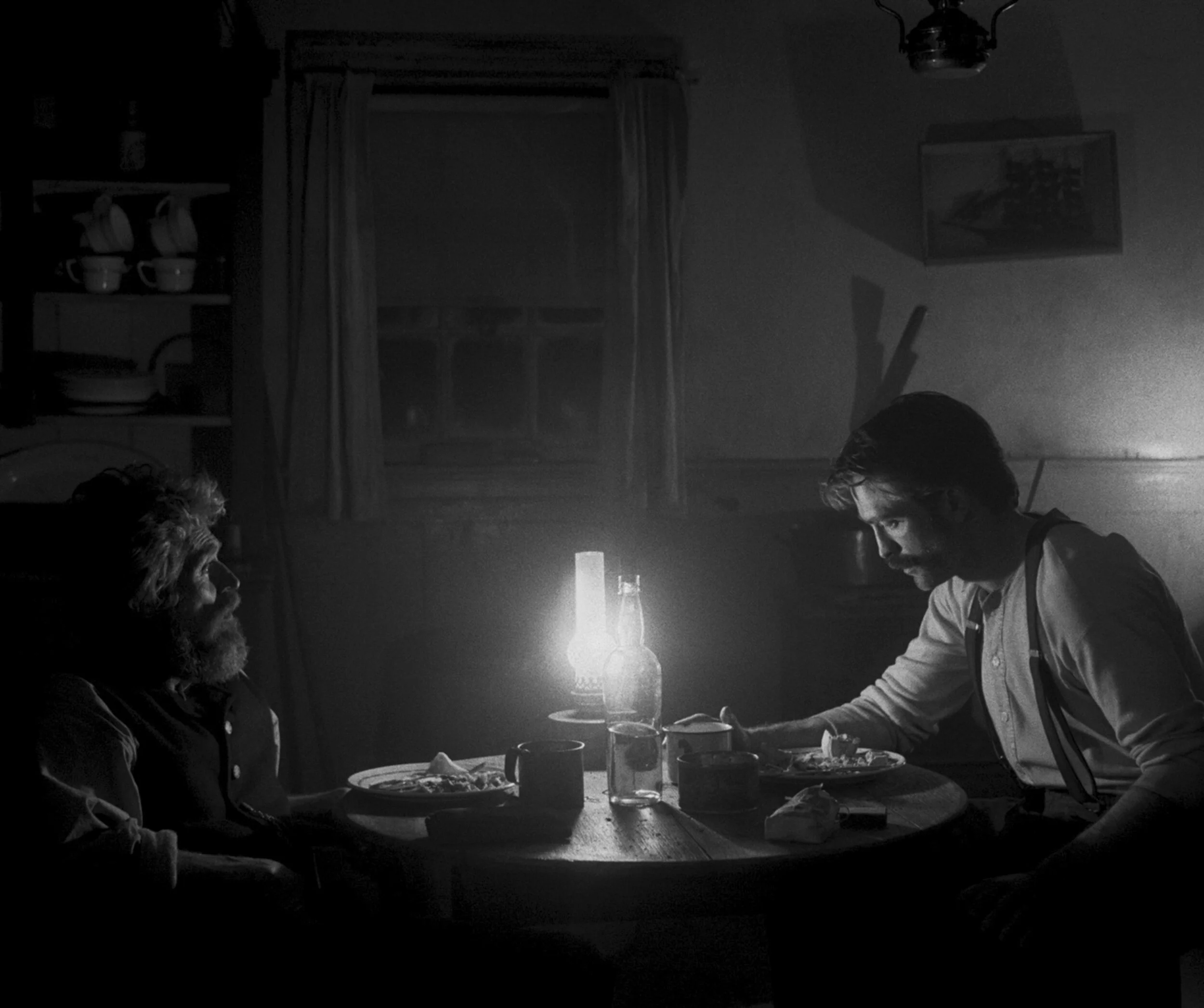Mark Korven
Mark Korven is the potent and mysterious award-winning sonic pioneer and multi-instrumentalist behind myriad cinematic works and serials including The Witch, In The Tall Grass, The Terror: Infamy, Cube, Our House, The Twilight Zone, Isabelle, Awakening the Zodiac, The Grocer’s Wife, I’ve Heard the Mermaids Singing, and Sam & Me. A dark lord of musical transmogrification, Mark concocts resounding spatial enigmas that heighten the senses. In 2016, he conjured The Apprehension Engine, a bespoke and disquieting instrument fashioned by Tony Duggan-Smith, designed to evoke maximum dread. In our discussion, Mark delves into his broad brushstroke scoring approach for Robert Eggers’ arresting period thriller, The Lighthouse, and reveals his greatest fear as a music maker.
Source: Koko Tchorbadjian
How has your dual background as an accomplished singer/songwriter and director of short films aided your path as a composer?
Let me just think about that for a little bit… Well, I’d say being a short filmmaker has definitely aided my path in that it’s made me more empathetic to filmmakers. When they arrive at my studio to hear some of my sketches, I have a tremendous camaraderie with them because it’s like, “Oh man, you made the movie fantastic.” I have some very, very small inkling of what they might have gone through and what it takes to make a movie because I really struggle to make my little short films, but that’s nothing compared to making a feature film. And it’s certainly nothing compared to a feature film like The Lighthouse that Rob made.
It’s been great as opposed to maybe some of my earlier days where composers tend to be very protective of their music — “Don’t mess with my score,” and that sort of thing. Now, it’s quite different, and I really feel, because of my short filmmaking experience, that we’re on the same team, just trying to make a good film.
Right. Now you can understand the director’s perspective because it’s familiar to you.
Absolutely, I really get it now.
You also raise a great point in that a composer could write an incredible piece of music, but if it doesn’t serve the scene in the right way, then you have to be able to say, “Okay, next” and move on.
Yeah, I think I am a little less married to ideas now because you realize that, in the end, it’s not really about you. It’s really about the film.
What is your most cherished aspect of musical storytelling?
Musical storytelling… Well, I like doing good horror films because it gives me tremendous freedom in terms of what I can do sonically. [Horror] is much less restrictive, and it’s wide open to experimentation. Because the horror scoring genre is so riddled with clichés, it’s often welcomed when you can find something that extends beyond that and surprises people. That’s often not the case when you’re doing something like dramatic scoring, where you have to paint within the borders a little bit more. Whereas, in horror film scoring, there’s more of a welcoming stance as far as being able to work outside those borders.
How did you formerly come to work with Robert Eggers on The Witch?
Well, I came to work with Rob — it was basically through a cattle call. He was in Toronto because they wanted to shoot The Witch in Northern Ontario. Rob was very specific about the kind of forest he wanted to shoot in, and the closest he could find to what he wanted was Northern Ontario. So, he was in Toronto and interviewing composers, so I met him and was very impressed because he pulled out this massive binder of all his pre-visualizations for the film. It was monstrous, and I thought, “This guy is very different.” He’s like no one else I’ve ever met — he’s very, very intense and serious. You could tell he was extremely hardworking and very literate, as well. That impressed me very much, and also it felt like, as people, we were similar in that neither one of us was very articulate because our “articulateness,” it always went down on the page or through the keyboard. Because Rob’s brilliance — it doesn’t really come through how he speaks, it comes through in his art. He’s a very introverted guy, and I am quite introverted as well, so I felt like there was a bit of a connection there.
At the time, there were like twelve other composers up for this cake, so I thought, “I really hate cattle calls. I just don’t want to do it.” And my wife said to me, “I have a feeling that you should submit for this and really go for it because I think you’d be right for it.” It was odd coming from her because she’s not a horror fan by any stretch of the imagination, but she was totally right. So, what I did was put together a video of me playing an instrument called the Swedish Nyckelharpa, which is a medieval boat instrument. It’s sort of like the push button violin of the 15th century. I thought it would work for the film, so I made a video to stand out from the pack. As soon as he heard the Nyckelharpa, he thought, “Yeah, this guy gets it. He’d be right for the film.” Then he asked me to do, and it all worked out.
What do you appreciate most about his distinctive approach to filmmaking?
Oh, boy. That’s a hard one because there are so many things I appreciate about what he does. I do like it that he always wants to push things as far as they can go. Rob is not a flake. He’s a guy who can totally make decisions. I’ve worked with other people that will really push outside the box, and it’s because they really don’t know what they want. But Rob keeps pushing and pushing, and then when he gets what he wants, he goes, “Boom, that’s it.” The gavel comes down; it’s done. Then he moves on. In that way, he can be easy to work with because once you have approval, you know you can move on, and I like that. It really feels like we’re on the same wavelength in a lot of ways.
Looking back from the completion of The Lighthouse, how would you describe the evolution of your collaborative dynamic, and what are the stylistic sympathies you share?
Well, stylistically, I’d say we both enjoy atonal music a lot when it works well with the picture — Rob loves that sort of thing. And for me, as a composer, being that I like to experiment and take it outside the normal, I really enjoy that part of it. Our collaborative dynamic was pretty much established with The Witch, in that he is a real tinkerer. He can just tinker forever until he makes that last choice, and the final decision is made. Our process was very similar on The Lighthouse as well.
Rob is a very non-traditional director in how he works with composers. The film is pretty much all in his head before he shoots it. The music is also pretty much all in his head before he makes the movie as well, even though he will tinker forever. So, it’s not at all the typical case where the composer will be brought in, there’ll be a blank slate, and the director might say, “Well, just try a whole bunch of things.” It’s not like that at all because he’s very specific about the direction of what he wants. So, in that way, he’s very non-traditional, and I think it’s pretty much like that with every element of his movies. It’s all about Rob’s vision and how he sees the film. The people on board are just trying to help him achieve that. It’s not so much about all the people involved in the film having their individual voices that they want to be heard. We’re all there to help Rob achieve his vision because we always know it’s going to be pretty special.
The Lighthouse is a mesmeric psychological thriller set in the late 19th century, which examines the chaotic interplay between two wickies and their alcohol and kerosene induced mental disintegration as a howling storm hits their secluded island. How early on in the process did you begin to write the score, and what were the first sonic experiments you embarked upon to establish the frenzied and mystic darkness unique to this film?
It was a long time ago, so it’s a little bit hard to recall. Rob and Louise Ford, the editor, will work a lot with temp music, so I’ll get that, and I’ll go, “Okay, how can I improve on this? How can I make it better?”. Then I’ll start throwing paint around on the canvas. Once I’ve got something that I think improves on that temp score, I sent it off to Rob to get his feedback. And then, it just kept going back and forth like that. That’s basically the process.
From the beginning, did you have the opportunity to score to picture, or were you just freely experimenting with soundscapes and textures?
No, there was picture. I like to hold off as long as I can before I start scoring because I know the script’s going to change, the rough assembly is going to change, everything is going to change. I’ve learned to wait as long as possible so that I don’t have to score twice.
That seems practical and the best use of your time. That makes me think about how important time management is when scoring animation or CGI dense films where everything is constantly changing.
For sure. Although with a film like this, it’s not as essential because, as we say in the business, we’re not Mickey Mouse-ing a lot of the cues. What I mean is that we’re not emphasizing each individual cut and hitting every little movement — it’s very much a broad brushstroke sort of approach.
Shot in black and white 35mm and presented in a nearly square aspect ratio, The Lighthouse transports the audience to New England in the 1890s. Did you have any period-specific musical references that inspired your score?
No, not really. Rob is extremely detailed when it comes to every other element in the production, the wardrobe, the sets, everything. But for the music, he doesn’t want to do that at all. However, he does want some kind of nod to the period, even if it’s a really, really loose nod. For The Witch, for example, the only nod to any kind of period music was the sound of the instruments and that Nyckelharpa sound. I mean, it’s a Swedish instrument, it’s not from Yorkshire or anything like that, but there was something witchy about it. There was something stiff about it, which sort of evoked an early Baroque feeling. Harmonically and melodically, it was completely divorced from anything from that period.
With The Lighthouse, Rob wanted there to be a connection with the sea, so we thought it should be some kind of wind instrument. You know, it’s possible that in this old lighthouse, there might be a little cornet or old trumpet lying around that they might play, or maybe an old wonky accordion or something like that. So, he thought, “Okay, those instruments might have actually been played by some lighthouse keepers.” Being that they’re wind instruments, there’s a lot of breath, wind, sea, and waves — there’s some kind of connection with the sea. That’s about as close as we came.
What were the parameters you worked within, and what precisely helped you decide upon the instrumentation that belonged to this world?
Well, that kind of came from the temp score, which was pretty much all atonal brass, and there was also some accordion in there. I actually used a bass melodica in a lot of it, which is like an accordion-like keyboard that you hold in your hand. I also played the accordion even though I don’t actually know how to play the accordion. I thought it would be best if I didn’t bring in a professional musician for something like that because I wanted it to be very loose and accidental. I really wanted it to be spontaneous and go with whatever sort of naturally came out of the instrument. I didn’t want it to sound too slick and polished.
Your wild and dissonant score for The Lighthouse functions as its own character, invoking lunacy and ambiguity. Which concepts within this hallucinatory tale did you deem most important to magnify with music?
You know, I don’t think neither one of us really saw it in those terms. It was just all about mood and just trying to evoke a feeling of the sea. I was just trying to underscore the conflict and the madness of the character, but we usually didn’t even talk much about that. It was really throwing paint at the canvas and swishing it around to see what felt right. Neither one of us really intellectualized about it much.
Did you intend to delineate between the clashing personalities of Ephraim and Tom, or was it more about creating atmosphere and dramatic tension?
Yeah, it was more about the atmosphere and dramatic tension, for sure.
Robert Pattinson and Willem Dafoe, they’re both incredible... Their performances [in The Lighthouse] were so full-on. I can’t even imagine what it must have been like to be on set.
I’ve heard a lot of stories about it because the shoot was very, very intense. I met with the crew at the party at TIFF, and they all compared it to going to war because of the conditions they had to deal with and how frigid it was. I think they shot a lot of in March, and this was out in the Maritimes. They were right out on the sea, and it was freezing cold, so you try putting a mermaid out there with no shirt on — pretty brutal. I heard they had to put hot packs all around her to keep her body temperature from dropping too low. Plus, they were doing things like putting [Robert] Pattinson up to his chin in the water at night with a couple of scuba divers underneath the water to make sure he didn’t drown. There was a lot of danger to the shoot going on as well. Kudos to them for being a super, super strong crew, but I mean, they all did it because they love [Robert] Eggers, and they love the film, so they all did their best.
Well, they really went the extra mile, and it paid off!
They did. If this wasn’t a really interesting film, a lot of them probably would have just walked off and left, but they all knew they were doing something special, so they stuck it out.
Can you tell us about your methods to craft a score that could both complement and co-exist with the gale-force winds, crashing waves, pouring rain, and other prominent sound design elements in The Lighthouse?
Unfortunately for me, I didn’t have that when I was working. I knew there would be tremendous possibilities sound-wise, but I probably would have written a different score if I would have heard a lot of the sound elements and how heavy it was going to be. There was really no strategy because I couldn’t really work with the sound. In reflection, I would have much preferred to have that, so I could score around it a little bit more because there were a lot of times where I thought, “I wish they would have pulled back on the sound a bit right here because I think the music could have done more for the scene.” There were definitely times that I felt like that. So, there you go.
There must have been a method to the madness, right? Was the sound design completed much later on?
Yeah, yeah. I’m not really sure. I mean, I have to say the sound design was brilliant, terrific work — there’s no question about it. Another way of looking at it, too, is that things were very much blended together. A lot of cues that I was used to hearing were then mixed with a great deal of surf and wind, so you could look at it like they became something else. They became a sort of hybrid, a kind of musical wind or something instead of just a music cue or just a wind cue.
Almost like a duet of some sort.
Yeah, almost.
Can you elaborate on your scoring approach for the instantly iconic mermaid masturbation sequence?
Oh, boy. Again, we really didn’t intellectualize about it. I was basically trying to make it as crazy and dramatic as I possibly could. With a lot of the stuff I do, I’m working my best to make it exciting and interesting to listen to. That’s really the approach I was taking there.
Interesting. I mean, every artist has thought processes going on, but it sounds like your experiences up until now are like grist for the mill, and then you go on gut and instinct. Does that sound about right?
Oh yeah, yeah. A lot of is instinctive, for sure. Well, certainly, a lot of what I do is instinctive.
Can you tell us about the genesis of The Apprehension Engine that you commissioned master luthier, Tony Duggan-Smith, to create?
Sure, sure. Well, this goes back to after I’d finished The Witch. I think this was in 2016, and I was asked to give a masterclass at TIFF. It was about two or three weeks before the masterclass, and I thought, “Well, wouldn’t it be neat to have an instrument built that I could show off in that masterclass?”. And so, I made a sort of Homer Simpson quality sketch of what I had envisioned with various things that I’d been playing for years like spring reverbs, hurdy-gurdy, a distorted guitar I played with Ebows, and things like that. I put all those together into a box, and then I asked my friend, Tony, to build it for me. He came up with something, and it arrived on the morning of the masterclass. I got it my house and then played with it for half an hour before taking it out to TIFF and attempted to get sounds out of it at the masterclass. It was pretty crazy for me to do, but it was fun. It really started from there.
Then after the masterclass, I put it up on the shelf, and I thought, “Well, I guess that’s about it for that.” About half a year later, I thought, “Well, I should make a video of this thing.”, so I brought it down and recorded a video of some of the sounds I’d been playing with all those months ago. I put it up on YouTube, and no one watched it. I was like, “Okay, that’s cool. Moving on.” and then suddenly, boom, it started getting all these hits, people started watching it, and it started going viral on me. Then CNN phoned up and wanted to do a feature on it for Great Big Story. It was weird because I had a viral hit on my hands for this thing. Next thing you know, I’m traveling to England, Spain, New York, Chicago, all over the place to perform on this thing. It was a very, very strange adventure.
How did you come up with the name, “The Apprehension Engine”?
Just after it was built, I was at a party with some friends of mine. While I was there, I said, “This is what I had built for me. Anyone got a good idea for a name?”. My friend, Zeb, goes, “Yeah, apprehension engine.” And I thought, “Well, that couldn’t be more perfect.”
Can you identify a cue in your repertoire that demonstrates the full range of what this compelling invention is capable of?
Well, I guess as far as like people wanting to hear what it does, it would probably be best to look on YouTube because there are all kinds of videos on the instrument. That would be best. I actually used a little bit of it in The Lighthouse but not too much.
In music and life, what are you most afraid of?
Music and life… In life, I guess the fears would be death and sickness, but in music? I’m afraid of being predictable and boring. Because it’s like someone said, “You can only commit one sin in filmmaking, and that’s to be boring.” That’s how I look at music. There’s only one sin you can create in music, and that’s to be boring. That’s absolutely my worst musical fear.
Interviewer | Paul Goldowitz
Research, Copy, Layout | Ruby Gartenberg
Editing | Alex Sicular, Ruby Gartenberg
Extending gratitude to Mark Korven.




